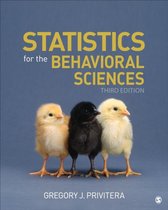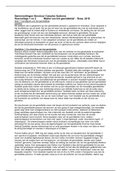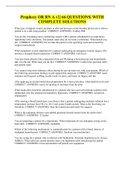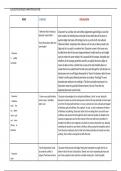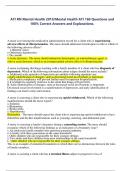Introduction to Statistical Analysis
CM1005
This summary includes:
Chapters 1, 3, 4 and 15
+ lecture notes week 1 through 7
By Esmée Lieuw On
ESMEE LIEUW ON 1
,Introduction to Statistical Analysis
Based on first edition (2012)
Chapter 1: Introduction to Statistics
Statistics: a branch of mathematics used to summarize, analyze and interpret a group of
numbers or observations
Descriptive statistics: statistics that summarize observations
Inferential statistics: statistics used to interpret the meaning of descriptive statistics
Descriptive Statistics
= Procedures used to summarize, organize and make sense of a set of scores/observations
referred to as data
• Typically presented graphically, in tabular form (tables) or summary (single values).
• Data: measurements/observations that are typically numeric (datum (singular) is
single measurement/observation often referred to as score or raw score.
Generally presented in summary (tables or summary statistics (ex. average))
Average = mean, middle = median, most common = mode
Inferential Statistics
= procedures used to allow researchers to infer/generalize observations made with samples
to the larger population from which they were selected
Population: set of individuals, items or data of interest. This is the group about
which scientists will generalize.
Population parameter: a characteristic (usually numeric) that describes a population
Scientists rarely have access to entire population therefore not always known
population parameters → alternative: sample
Sample: set of selected individuals, items or data taken from a population of interest
Sample statistic: a characteristic (usually numeric) that describes a sample
Scales of Measurement
= rules for how properties of numbers can change with different uses
Order: Does the larger number indicate a greater value than a smaller number?
Differences: Does subtracting two numbers represent some meaningful value?
Ratio: Does dividing (or taking the ratio of) two numbers represent some meaningful value?
Property Nominal Ordinal Interval Ratio
Order No Yes Yes Yes
Difference No No Yes Yes
Ratio No No No Yes
ESMEE LIEUW ON 2
,Numbers on nominal scale identify something or someone; they prove no additional
information. (ex. Zip codes, credit card numbers, license plate numbers etc.)
They are measurements where a number is assigned to represent something or
someone
Coding: the procedure of converting a nominal value to a numeric value (ex. Seasons
of birth coded into 1,2,3,4)
Ordinal scales are measurements where values convey order or rank alone (ex. Finishing
order in competition, education level and rankings).
Only some value greater/less than other value → differences between ranks do not
have meaning
Interval scales are measurements where the values have no true zero and the distance
between each value is equidistant (equal). (ex. Rating scales; unsatisfied-very satisfied)
A numeric response scale used to indicate a participant’s level of agreement/opinion
with a statement
Equidistant scales: The values whose intervals are distributed in equal units
No true zero (ex. Temperature → it doesn’t mean there’s no temperature; arbitrary
zero point (so we could use any number to indicate none of something) (ex.
Longitude/latitude)
True zero: values where the value 0 truly indicates nothing
Ratio scales are measurements where a set of values has a true zero and are equidistant
(ex. Length, weight, time)
Differences are informative: the difference between 70 and 60 = the difference
between 20 and 30
Types of Data
1. Continuous/Discrete
2. Quantitative/Qualitative
Continuous/Discrete
Continuous variable: measured along a continuum at any place beyond the decimal
point (in whole units or fractional units). (ex. Olympic sprinters are timed to the
nearest hundredths place in seconds, but if judges wanted the millionth place they
could).
Discrete variable: measured in whole units or categories (ex. Number of siblings or
economic class; working, middle, upper class)
Quantitative/Qualitative
Quantitative variable: varies by amount, often measured numerically and often
collected by measuring/counting. (ex. Food intake in calories or number of pieces
food consumed)
ESMEE LIEUW ON 3
, Qualitative variable: varies by class, often represented as a label and describes
nonnumeric aspects of phenomena (ex. Socioeconomic class, depression or drug
use)
Example Continuous vs. Discrete Quantitative vs. Qualitative
Gender Discrete Qualitative
Seasons Discrete Qualitative
Duration of drug abuse (in Continuous Quantitative
years)
The size of a reward (in Continuous Quantitative
grams)
Research in Focus: Types of Data and Scales of Measurement
Qualitative variables often measured in behavioral research; focus will be on quantitative
variables because:
1) Quantitative measures are more common in behavioral research
2) Most statistical tests taught in the book are adapted for quantitative measures
3) Conclusions that we can draw from qualitative data are limited because these data
are typically on nominal scale
4) Most statistics in the book require variables to be measured on more informative
scales
SPSS in Focus: Entering and Defining Variables
• “How to use SPSS with this book” at the beginning of the book is useful to read
• Read through to know how to enter data
Chapter 3: Summarizing Data – Central Tendency
Introduction to Central Tendency
Central tendency: statistical measures for locating a single score that is most representative
or descriptive of all scores in a distribution
Have a tendency to be at or near the center of a distribution
Population size: number of individuals that constitute an entire group/population.
Represented by capital N.
Sample size: number of individuals that constitute a subset of those selected from a larger
population. Represented by lower case n.
Measures of Central Tendency
ESMEE LIEUW ON 4
CM1005
This summary includes:
Chapters 1, 3, 4 and 15
+ lecture notes week 1 through 7
By Esmée Lieuw On
ESMEE LIEUW ON 1
,Introduction to Statistical Analysis
Based on first edition (2012)
Chapter 1: Introduction to Statistics
Statistics: a branch of mathematics used to summarize, analyze and interpret a group of
numbers or observations
Descriptive statistics: statistics that summarize observations
Inferential statistics: statistics used to interpret the meaning of descriptive statistics
Descriptive Statistics
= Procedures used to summarize, organize and make sense of a set of scores/observations
referred to as data
• Typically presented graphically, in tabular form (tables) or summary (single values).
• Data: measurements/observations that are typically numeric (datum (singular) is
single measurement/observation often referred to as score or raw score.
Generally presented in summary (tables or summary statistics (ex. average))
Average = mean, middle = median, most common = mode
Inferential Statistics
= procedures used to allow researchers to infer/generalize observations made with samples
to the larger population from which they were selected
Population: set of individuals, items or data of interest. This is the group about
which scientists will generalize.
Population parameter: a characteristic (usually numeric) that describes a population
Scientists rarely have access to entire population therefore not always known
population parameters → alternative: sample
Sample: set of selected individuals, items or data taken from a population of interest
Sample statistic: a characteristic (usually numeric) that describes a sample
Scales of Measurement
= rules for how properties of numbers can change with different uses
Order: Does the larger number indicate a greater value than a smaller number?
Differences: Does subtracting two numbers represent some meaningful value?
Ratio: Does dividing (or taking the ratio of) two numbers represent some meaningful value?
Property Nominal Ordinal Interval Ratio
Order No Yes Yes Yes
Difference No No Yes Yes
Ratio No No No Yes
ESMEE LIEUW ON 2
,Numbers on nominal scale identify something or someone; they prove no additional
information. (ex. Zip codes, credit card numbers, license plate numbers etc.)
They are measurements where a number is assigned to represent something or
someone
Coding: the procedure of converting a nominal value to a numeric value (ex. Seasons
of birth coded into 1,2,3,4)
Ordinal scales are measurements where values convey order or rank alone (ex. Finishing
order in competition, education level and rankings).
Only some value greater/less than other value → differences between ranks do not
have meaning
Interval scales are measurements where the values have no true zero and the distance
between each value is equidistant (equal). (ex. Rating scales; unsatisfied-very satisfied)
A numeric response scale used to indicate a participant’s level of agreement/opinion
with a statement
Equidistant scales: The values whose intervals are distributed in equal units
No true zero (ex. Temperature → it doesn’t mean there’s no temperature; arbitrary
zero point (so we could use any number to indicate none of something) (ex.
Longitude/latitude)
True zero: values where the value 0 truly indicates nothing
Ratio scales are measurements where a set of values has a true zero and are equidistant
(ex. Length, weight, time)
Differences are informative: the difference between 70 and 60 = the difference
between 20 and 30
Types of Data
1. Continuous/Discrete
2. Quantitative/Qualitative
Continuous/Discrete
Continuous variable: measured along a continuum at any place beyond the decimal
point (in whole units or fractional units). (ex. Olympic sprinters are timed to the
nearest hundredths place in seconds, but if judges wanted the millionth place they
could).
Discrete variable: measured in whole units or categories (ex. Number of siblings or
economic class; working, middle, upper class)
Quantitative/Qualitative
Quantitative variable: varies by amount, often measured numerically and often
collected by measuring/counting. (ex. Food intake in calories or number of pieces
food consumed)
ESMEE LIEUW ON 3
, Qualitative variable: varies by class, often represented as a label and describes
nonnumeric aspects of phenomena (ex. Socioeconomic class, depression or drug
use)
Example Continuous vs. Discrete Quantitative vs. Qualitative
Gender Discrete Qualitative
Seasons Discrete Qualitative
Duration of drug abuse (in Continuous Quantitative
years)
The size of a reward (in Continuous Quantitative
grams)
Research in Focus: Types of Data and Scales of Measurement
Qualitative variables often measured in behavioral research; focus will be on quantitative
variables because:
1) Quantitative measures are more common in behavioral research
2) Most statistical tests taught in the book are adapted for quantitative measures
3) Conclusions that we can draw from qualitative data are limited because these data
are typically on nominal scale
4) Most statistics in the book require variables to be measured on more informative
scales
SPSS in Focus: Entering and Defining Variables
• “How to use SPSS with this book” at the beginning of the book is useful to read
• Read through to know how to enter data
Chapter 3: Summarizing Data – Central Tendency
Introduction to Central Tendency
Central tendency: statistical measures for locating a single score that is most representative
or descriptive of all scores in a distribution
Have a tendency to be at or near the center of a distribution
Population size: number of individuals that constitute an entire group/population.
Represented by capital N.
Sample size: number of individuals that constitute a subset of those selected from a larger
population. Represented by lower case n.
Measures of Central Tendency
ESMEE LIEUW ON 4

